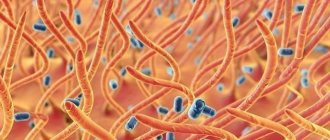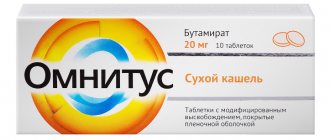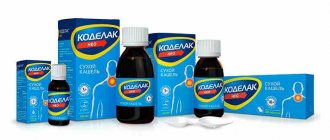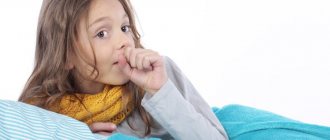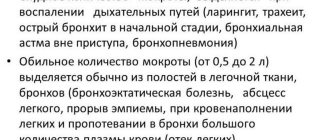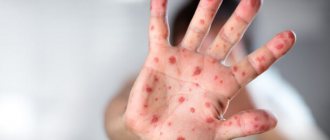Whooping cough in a child is an infectious disease that is accompanied by paroxysmal coughing. The name comes from "coqueluche" - the French word for the crow of a rooster. The first researchers of the disease believed that it was these sounds that resembled whooping cough.
In the Middle Ages, whooping cough claimed the lives of many young children. With the advent of vaccination, the incidence of whooping cough has decreased significantly, but the infection is still considered dangerous today. It poses a particular threat to children under 2 years of age.
Knowing the characteristics of the disease, caring parents can significantly alleviate the baby’s condition at home. Read our article on how to recognize the first symptoms of whooping cough and prevent its unfavorable development.
Whooping cough symptoms
Initial signs appear in children one to two weeks after infection. The insidiousness of whooping cough lies in the fact that at an early stage its symptoms are similar to a common cold. The child may be bothered by:
- a sore throat;
- slight runny nose;
- general weakness;
- dry cough;
- low-grade fever.
A distinctive feature of the whooping cough bacillus is that it never causes a temperature rise above 38° C. Therefore, if the thermometer shows 38° C or higher in the baby, whooping cough can be immediately ruled out. On the other hand, if treatment with antitussives does not provide relief, this may serve as an additional warning sign.
A sick person may not suffer from a strong cough in the first days, but it is during this time that whooping cough is especially contagious. 20 days after the onset of catarrhal symptoms, the child no longer poses any threat to others. In children's institutions, when cases of whooping cough are detected, quarantine is declared for 21 days.
After 1-2 weeks, the intensity of the attacks increases, becoming more painful for the child every day. Whooping cough is so unique that a doctor only needs to hear it to make a correct diagnosis.
Many young children have a very difficult time with this cough. It may be accompanied by suffocation, vomiting, and expectoration. As you inhale, the spasmodic airways and ligaments make a whistling sound. In this case, the neck veins are inflated, microhemorrhages and rupture of the lingual frenulum are possible.
During the day, the cough can be repeated from 5 to 50 times, intensifying at night and in the morning. Outside of attacks, painful symptoms do not appear, and the child most often feels well. An increase in temperature at this stage of the disease usually indicates the occurrence of complications.
A spasmodic cough lasts for about a month or more, gradually becoming less intense. However, it is possible to completely get rid of it no earlier than after three months. And symptoms such as weakness and increased nervousness persist in the child even longer.
The paradoxical feature of cough is that it continues for a long time after the death of the bacteria in the body that causes it. After the third week of illness, the number of whooping cough bacilli gradually disappears on its own.
However, during this time another pathological mechanism appears. It is associated with a nervous reflex, which the brain continues to send as if “by inertia”. The body gets so used to coughing that it takes a long time to get rid of this unpleasant symptom. Pediatricians have the term “hundred-day cough,” which is used as a synonym for whooping cough. It is necessary to treat spasmodic cough with specific means that are not harmless for the child. But if you follow special recommendations, then it will go away without a trace over time.
Diagnostics
After consultation and examination of the patient by doctors, the diagnosis and conclusion are established by an infectious disease specialist and pediatrician. One of the main symptoms of diagnosis is a paroxysmal specific cough. But to obtain a complete picture of the disease, it is necessary to conduct a series of laboratory tests.
These include:
- Bacteriological examination of a smear of mucus from the throat and nose with isolation of whooping cough bacillus. For this purpose, sputum collection is used when coughing. The second method of collection is using a swab from the pharyngeal mucosa in the morning on an empty stomach or 2-3 hours after eating. Both materials are placed in a nutrient medium and, through laboratory tests, a picture is obtained of the presence of the pathogen - pertussis bacillus. The results are ready in 5-7 days.
- Serological tests are used at later sample collections to detect antibodies to pertussis. Their main goal is to detect immunoglobulins lgM in the blood and lgA in mucus. These bodies are vital for several months after the disease. Within a month, immunoglobulin IgG is formed, which persists for several years and can give an answer as to whether the patient has had whooping cough before.
- A general blood test makes it possible to determine an increase in the number of leukocytes and lymphocytes with a normal ESR. This method is called hematological.
There are a number of laboratory research methods for diagnosing whooping cough, including express methods.
Possible complications
In children under one year of age, whooping cough is dangerous due to the possibility of holding their breath during attacks, which can lead to tissue hypoxia. Due to lack of oxygen, muscle cramps and encephalopathy may occur. In severe forms, parents need to decide whether to treat whooping cough in a hospital.
Due to secondary infection against the background of whooping cough, the following most often develop:
- obstructive bronchitis;
- pneumonia;
- laryngitis;
- pleurisy;
- otitis;
- false croup
Whooping cough greatly weakens the immune defense, which in children is already insufficiently formed. Therefore, for safety, it is better to refrain from visiting kindergarten or school for at least a month, and preferably 5-6 weeks.
Main reasons
Whooping cough develops under the influence of specific bacteria Bordetella pertussis (Bordet-Gengou bacillus, pertussis bacillus, bordetella). The source of infection is a sick person; the greatest danger in terms of infection is the acute period of typical and atypical forms of infection. Patients with erased forms of the disease and carriers of Bordetella pertussis are also contagious, although in the latter case the carriage of the bacteria does not last long and therefore does not play a decisive role in the spread of whooping cough.
Bordetella pertussis has a close relative, a bacterium called Bordetella parapertussis. Infection with this microorganism causes the development of parawhooping cough - the disease manifests itself with symptoms similar to whooping cough, but they are much easier to tolerate.
Routes of infection
The pertussis bacillus is extremely sensitive to the effects of ultraviolet rays, high and low temperatures, and disinfectants. Therefore, its viability in the environment does not last long. Infection occurs due to the release of the pathogen by the patient at the time of sneezing or coughing. The microorganism can spread in the air no more than 2-3 meters - the infection is transmitted by airborne droplets only through close contact.
The patient is most contagious in the last days of incubation and in the first 5-7 days of the initial stage, that is, at a time when the disease is quite difficult to diagnose. Unvaccinated children become infected with the bacterium in 90-100% of cases, and their disease is very severe.
After successful treatment, immunity to whooping cough remains for a long time; with a pronounced weakening of the body's defenses and in old age, re-infection is possible.
The likelihood of developing whooping cough remains in vaccinated babies, but the disease in them is generally mild and does not cause complications. The infection is not characterized by seasonality, although a peak in cases is observed in autumn and winter.
Treatment of whooping cough in children
The optimal time to suppress pertussis is the first 10-14 days after infection. If the diagnosis is confirmed at an early stage using sputum analysis or blood diagnostics, then the simplest antibiotics quickly cope with the infection. A course of antibiotics helps prevent painful coughing attacks.
The effectiveness of antimicrobial treatment at the onset of the disease is due to the fact that pertussis bacillus does not develop resistance to antibiotics. Unfortunately, this period is often missed due to the lack of specific symptoms. Let us remember that whooping cough initially looks like a mild acute respiratory infection.
Two weeks later, when the typical “barking cough” begins, it is almost pointless to take antibiotics, since the body has already coped with the pathogen. It turns out that medicine has an available medicine to treat whooping cough, but in practice it is rarely possible to prescribe it to a child on time.
Among pharmacological agents, the doctor may prescribe antitussives and bronchodilators, as well as mucolytics. In cases of severe, debilitating attacks, treatment with antipsychotics to suppress the cough reflex is warranted.
If necessary, the pediatrician recommends therapeutic treatment: inhalation of humidified oxygen, removal of mucus from the respiratory tract.
Preventing illness with antibiotics
Erythromycin is an antibacterial drug that can and should be used for prophylactic purposes.
Evgeny Olegovich Komarovsky, a famous pediatrician who is categorically against prophylactic use of antibiotics, has the following point of view on this issue: “Whooping cough is one of the few diseases that requires taking antibiotics for prophylactic purposes. Erythromycin, taken before the onset of cough as the main symptom of the disease, helps prevent the development of attacks and prevent all possible complications. Erythromycin does not have a significant negative effect on the intestines, liver and other internal organs. It is a safe and effective means of preventing whooping cough.”
An antibiotic should be taken if a child or adult has likely had contact with a person with whooping cough. For example, in a situation where there is a child in the family who has been diagnosed with whooping cough, everyone in his immediate circle needs to take an antibacterial drug. Moreover, it does not matter whether adults were vaccinated in childhood.
How to help someone with whooping cough at home
Supportive treatment and the creation of optimal home conditions for recovery come to the fore. If a child gets whooping cough, doctors advise following the following recommendations.
Special indoor microclimate
The air in a child's room dramatically affects the duration of whooping cough treatment. Practice shows: if the air a child breathes is cool and moist, then coughing attacks are resolved much faster and easier than in a normal “room” atmosphere, when the house is warm and dry.
To alleviate the baby’s condition, try to maintain the temperature in his room no more than +16 ° C, and the humidity up to 50%. Avoid the presence of provoking factors in the air, such as tobacco smoke, strong chemical, perfume and floral odors. Don't forget to ventilate the room regularly.
Gentle diet
For a weakened child's body, fractional meals are indicated. Swallowing movements provoke coughing, so a small child may instinctively refuse to eat out of fear. Feed your baby in small portions 5-6 times a day, mostly liquid or pureed food.
Limiting external stimuli
Try to provide your child with a comfortable psychological environment. Do not focus attention on the disease, on the contrary, distract and pamper with pleasant surprises. A new toy or interesting cartoons can become invaluable helpers in a speedy recovery. While the baby is very carried away, his brain simply forgets to send cough signals. Allow the little patient a little more than usual. Sometimes this helps against whooping cough better than an expensive pill.
Inhalations
For home inhalations, it is best to use a children's nebulizer with a reduced noise level. Ask your doctor to prescribe the necessary medications. Before visiting the doctor, you can do inhalations with saline solution.
Walks in the open air
If your child has a normal temperature, go out for walks with him more often. This is necessary to eliminate the symptoms of hypoxia and congestion in the respiratory system. Walking after rain and near sources of air humidification: ponds, fountains are especially useful.
Which doctor should I contact?
If you feel unwell, you should visit a pediatrician. The doctor will ask if you have had contact with anyone who is coughing or who has whooping cough. He will listen to your lungs and ask for a blood test. The child may also be referred to an ENT specialist for consultation or to an infectious disease specialist.
An ENT specialist will examine the throat and the condition of the mucous membrane of the larynx and pharynx. In the presence of swelling of the mucous membrane and hemorrhages, as well as light mucopurulent exudate, the presence of a bacterial bacillus will be determined.
Based on the results of examination and conversation, an infectious disease doctor is able to make a presumptive diagnosis. He is more likely to order additional tests.
Treatment of childhood whooping cough using folk methods
Traditional methods are not capable of radically eliminating this childhood disease, however, neither are traditional remedies. However, in some cases they can alleviate the cough, and therefore the general well-being of the child. Traditional medicine advises for whooping cough:
- Boil potatoes, onions and apples in 1 liter of water until the amount of water boils by half. Give the decoction 1 teaspoon 3 times a day.
- Melt a tablespoon of sugar in a frying pan, then carefully pour in a glass of boiling water and stir carefully. Drink 1 teaspoon 4-5 times a day, including at night.
- Drink a decoction of plantain leaves.
- A tasty and nutritious remedy is a decoction of figs in milk. It not only relieves cough, but also satisfies hunger well.
If there is poor sputum secretion, massage of the chest and back with a few drops of fir oil, garlic or radish juice helps a lot. Inhalation of phytoncides suppresses pertussis bacteria, and massage helps clear the airways of viscous mucus.
Etiology and epidemiology
The causative agent of whooping cough is a bacillus containing endotoxin and other components. Lymphocytes increase sharply in this disease. However, the pathogen quickly dies outside the body of an infected person. Therefore, the likelihood of infection through various objects or toys is very low.
A sick person is contagious for 25-30 days, and in some cases up to two months. You can become infected by communicating with a sick person, especially when he coughs. Most often, whooping cough occurs in early preschool age.
The pathogen persists in the nasopharynx for 35-42 days. The endotoxin that the pathogen produces causes a persistent and severe cough that is convulsive in nature. This is explained by the emergence of a set of closely located and physiologically active elements of the central nervous system. Coughing attacks occur due to factors that irritate the bronchi, such as dust, other viruses, and air pollution. Even after complete recovery, after several months, whooping cough may begin again if you get the flu, pneumonia or measles.





